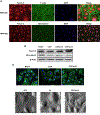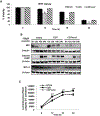Fascin2 regulates cisplatin-induced apoptosis in NRK-52E cells
- PMID: 27989596
- PMCID: PMC7074922
- DOI: 10.1016/j.toxlet.2016.11.021
Fascin2 regulates cisplatin-induced apoptosis in NRK-52E cells
Abstract
Previous studies have shown that the aging kidney has a marked loss of α(E)-catenin in proximal tubular epithelium. α-Catenin, a key regulator of the actin cytoskeleton, interacts with a variety of actin-binding proteins. Cisplatin-induced loss of fascin2, an actin bundling protein, was observed in cells with a stable knockdown of α(E)-catenin (C2 cells), as well as in aging (24 mon), but not young (4 mon), kidney. Fascin2 co-localized with α-catenin and the actin cytoskeleton in NRK-52E cells. Knockdown of fascin2 increased the susceptibility of tubular epithelial cells to cisplatin-induced injury. Overexpression of fascin2 in C2 cells restored actin stress fibers and attenuated the increased sensitivity of C2 cells to cisplatin-induced apoptosis. Interestingly, fascin2 overexpression attenuated cisplatin-induced mitochondrial dysfunction and oxidative stress in C2 cells. These data demonstrate that fascin2, a putative target of α(E)-catenin, may play important role in preventing cisplatin-induced acute kidney injury.
Keywords: Actin; Aging; Apoptosis; Fascin2; Mitochondria; α-Catenin.
Copyright © 2016 Elsevier Ireland Ltd. All rights reserved.
Conflict of interest statement
Conflicts of interest
The authors declare that there are no conflicts of interest.
Figures





Similar articles
-
Loss of α(E)-catenin potentiates cisplatin-induced nephrotoxicity via increasing apoptosis in renal tubular epithelial cells.Toxicol Sci. 2014 Sep;141(1):254-62. doi: 10.1093/toxsci/kfu130. Epub 2014 Jun 27. Toxicol Sci. 2014. PMID: 24973089 Free PMC article.
-
Loss of α(E)-catenin promotes Fas mediated apoptosis in tubular epithelial cells.Apoptosis. 2015 Jul;20(7):921-9. doi: 10.1007/s10495-015-1129-x. Apoptosis. 2015. PMID: 25894537 Free PMC article.
-
Paracrine Activation of the Wnt/β-Catenin Pathway by Bone Marrow Stem Cell Attenuates Cisplatin-Induced Kidney Injury.Cell Physiol Biochem. 2017;44(5):1980-1994. doi: 10.1159/000485904. Epub 2017 Dec 11. Cell Physiol Biochem. 2017. PMID: 29237155
-
Autophagy delays apoptosis in renal tubular epithelial cells in cisplatin cytotoxicity.Autophagy. 2008 Jul;4(5):710-2. doi: 10.4161/auto.6309. Epub 2008 May 20. Autophagy. 2008. PMID: 18497570 Review.
-
The Predictive Role of the Biomarker Kidney Molecule-1 (KIM-1) in Acute Kidney Injury (AKI) Cisplatin-Induced Nephrotoxicity.Int J Mol Sci. 2019 Oct 22;20(20):5238. doi: 10.3390/ijms20205238. Int J Mol Sci. 2019. PMID: 31652595 Free PMC article. Review.
Cited by
-
Effect of cell cycle synchronization on cadmium-induced apoptosis and necrosis in NRK-52E cells.Cell Cycle. 2020 Dec;19(23):3386-3397. doi: 10.1080/15384101.2020.1848065. Epub 2020 Nov 23. Cell Cycle. 2020. PMID: 33222613 Free PMC article.
-
Biosynthesis, characterization, and anticancer effect of plant-mediated silver nanoparticles using Coptis chinensis.Int J Nanomedicine. 2019 Mar 15;14:1969-1978. doi: 10.2147/IJN.S188235. eCollection 2019. Int J Nanomedicine. 2019. PMID: 30936697 Free PMC article.
-
Loss of Fascin2 increases susceptibility to cisplatin-induced hearing impairment and cochlear cell apoptosis in mice.J Otol. 2024 Jul;19(3):133-139. doi: 10.1016/j.joto.2024.07.001. Epub 2024 Oct 19. J Otol. 2024. PMID: 39735238 Free PMC article.
References
-
- Adams JC, 2004. Roles of fascin in cell adhesion and motility. Curr. Opin. Cell Biol 16, 590–596. - PubMed
-
- Arora P, Kher V, Kohli HS, Sharma RK, Gupta A, Jha R,1993. Acute renal failure in the elderly: experience from a single centre in India. Nephrol. Dial. Transplant 8, 827–830. - PubMed
-
- Baraldi A, Ballestri M, Rapana R, Lucchi L, Borella P, Leonelli M, Furci L, Lusvarghi E, 1998. Acute renal failure of medical type in an elderly population. Nephrol. Dial. Transplant 13 (S7), 25–29. - PubMed
-
- Bolignano D, Mattace-Raso F, Sijbrands EJ, Zoccali C, 2014. The aging kidney revisited: a systematic review. Ageing Res. Rev 14, 65–80. - PubMed
MeSH terms
Substances
Grants and funding
LinkOut - more resources
Full Text Sources
Other Literature Sources
Molecular Biology Databases
Research Materials
Miscellaneous

